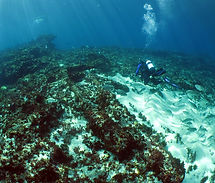
Batavia
GPS: S 28° 29.506'
E 113° 47.518'
Location: Walabi Group, Abrolhos Islands
Site depth: 7 metres
Divable conditions: <1.0 metre swell
Visibilty: 10 metres +
Vessel: VOC Retourship
Construction: Wood
Tons: 650 tons
Vessel length: 56 metres
Wreck event: Wrecked on reef 1629
Carrying 322 crew and passengers, the 650 ton Batavia is one of the most infamous and historically significant wrecks on the Australian coastline. Wrecked in 1629 on Morning Reef in the Wallabi group of the Abrolhos Islands off Geraldton. It is the second ever recorded shipwreck in Australian history with a gruesome story of survival, mutiny and massacre among the survivours of the wreck. With the women forced as concubines while the weak, unwilling and sick were murdered. Of the 268 castaways marooned on the surrounding islands, less than 150 remained alive on the 17th September when Commander Fransico Pelseart returned on the ship the "Sardam". After being arrested the mutineers were tortured into confessing and eventually, all but two had their hands severed before facing the gallows erected on Long Island. Two young mutineers Jan Pelgrom and Wouter Loos were given mercy and marooned near the mouth of the Murchison River in Kalbarri. The first two Europeans to be left to survive on mainland Australia 140 years before Captain Cook first discovered the east coast of Australia




The site lays on the seaward side of Morning Reef and is exposed to swell and wind making it a difficult site to dive in all but the best conditions. The site has been fully excavated however, many of the cannons and anchors remain surrounding a large sand hole that was once the stern of the ship in around 7 metres of water.